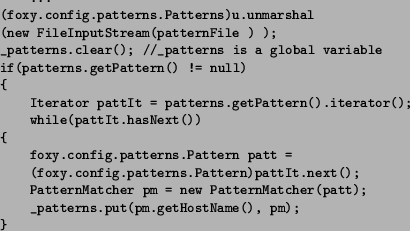foxy.config
The classes in the foxy.config package have all been automatically
created by Sun's Java Architecture for XML Binding (JAXB).
JAXB creates Java-source-files out of an XML Schema description.
The generated Java classes represent the structure of the Schema definition.
This not only eases the reading and writing of XML-data, it also
ensures that the data is compliant to a certain Schema.
The foxy.config package consists of three sub-packages:
rules, patterns and server - each one responsible for the configuration-data
of the same name.
The classes in the root of these sub-packages are more or less a
''Java-representation'' of the elements described in the corresponding Schema-file.
From outside the package, we only have deal with these objects (named after
their underlying XML-elements) and do not need to parse the configuration-files
by our own.
Figure 2.5 shows an example for reading in the server's (HTTP-request-)patterns configuration file:
Figure 2.5:
Reading an XML-file compliant to the W3C XML Schema of the patterns-configuration file-format
 |
After ''importing'' the patterns-file into Java (a process called unmarshalling),
all data from the XML-file is accessible through the Patterns-structure returned
by the Unmarshaller.
The Pattern-object has only one public accessible function, getPattern(),
which returns an instance of the java.util.List-class that contains a list
of Pattern-objects.
This procedure is similar to the synchronization of the rules-configuration data.
Although we could use these objects directly, we decided to wrap the data into
more appropriate data-structures to facilitate the proxy server's runtime-performance.
In figure 2.6 we create a Hashtable of PatternMatcher-objects (see section 2.3.2) at runtime after the unmarshalling of the Patterns-element.
Figure 2.6:
Example: Wrapping JAXB-created Pattern-objects into FOXY's PatternMatcher class
 |
A more detailed description of structure and usage of the configuration-files can
be found in section 2.4.
root
2006-05-22
